Upgrading of the L-P Band Cryogenic Receiver of the Sardinia Radio Telescope: A Feasibility Study
Abstract
:1. Introduction
2. Architecture of the Original L-P Band Cryogenic Receiver of SRT
- The L-P band coaxial feeds, working at ambient temperature (i.e., 300 K);
- The Dewar (or cryostat) block that works at cryogenic temperature of about 20 K;
- The cooling system, which enables the Dewar refrigeration;
- The noise calibration unit, useful for the receiver calibration for both P-band and L-band, thanks to the injection of a noise source (using the broadband microwave coaxial noise source NST26-B model from Micronetics [31]) in the RF signal acquisition chains;
- The P-band and L-band polarizer blocks, which permit us to also obtain the circular polarization;
- The P-band and L-band filter selector blocks, which allow us to select the suitable microwave filter for radio astronomy observations.
- A band pass filter (BPF) centered at 357.5 MHz with a bandwidth of about 120 MHz (model 5B340-357.5/T120-O/O from K&L, Salisbury, MD, USA [43]). It is a five-pole tubular filter with a −3 dB bandwidth from 295 MHz to 420 MHz and an insertion loss less than 1 dB;
- A BPF centered at 330 MHz with a bandwidth of 50 MHz (model 5B340-330/T5O-O/O from K&L, Salisbury, MD, USA [43]). In particular, it is a five-pole tubular filter with a −3 dB frequency response in the frequency range between 300 MHz and 360 MHz, and an insertion loss less than 1 dB;
- A BPF centered at 410 MHz with a bandwidth of 16 MHz (model 3B110-410/T15-O/O from K&L, Salisbury, MD, USA [43]). In detail, it is a three-pole tubular filter with a −3 dB bandwidth from 402 MHz to 418 MHz and an insertion loss of about 1 dB.
- A BPF centered at 1540 MHz with a bandwidth of 520 MHz (model 5B120-1540/T520-O/O from K&L, Salisbury, MD, USA [43]). In particular, it is a five-pole tubular filter with a −3 dB frequency response in the frequency range between 1250 MHz and 1820 MHz, and an insertion loss less than 1.5 dB;
- A BPF centered at 1400 MHz with a bandwidth of 120 MHz (model 5B120-1400/T120-O/O from K&L, Salisbury, MD, USA [43]). In detail, it is a five-pole tubular filter with a −3 dB bandwidth from 1340 MHz to 1460 MHz and an insertion loss less than 1.5 dB;
- A BPF centered at 1655 MHz with a bandwidth of 120 MHz (model 5B120-1655/T120-O/O from K&L, Salisbury, MD, USA [43]). In particular, it is a five-pole tubular filter with a −3 dB bandwidth from 1570 MHz to 1730 MHz and an insertion loss less than 1 dB;
- The combination of three cascaded filters in order to obtain an observation bandwidth in the range between 1300 MHz and 1800 MHz, cutting the main RFIs at 1310–1340 MHz and 1790–1960 MHz. These three filters are: a band rejection (Notch) filter (model 6N45-1320/E62.7-O/O from K&L, Salisbury, MD, USA [43]), a BPF centered at 1540 MHz with a bandwidth of 520 MHz (model 5B120-1540/T520-O/O from K&L, Salisbury, MD, USA [43]) and another Notch filter (model 6NS11-1880/E138-O/O from K&L, Salisbury, MD, USA [43]).
3. Study of the Receiver Criticalities and Workflow for the Upgrading Feasibility Study
3.1. Mitigation of the RFIs Derived from the Surrounding Area
- One of the Vivaldi antennas of the new Sardinia Aperture Array Demonstrator (SAD) telescope, with its dedicated signal acquisition chain [45,46], is shown in Figure 6. This system is located close to the SRT area and it is designed to cover the frequency range 50–500 MHz, with an antenna gain of about 8 dBi. It represents a useful fixed station, operating automatically and remotely in order to guarantee continuous data acquisition 24 h per day, and 7 days per week. In this way, it is possible to map the RFI scenario around SRT, detecting both continuous and impulsive signals. Further details of the system are described in [45,46].
- The RFI mobile laboratory, depicted in Figure 7, that was designed with the aim to have a very high sensitivity and a large linear dynamic range, without neglecting to limit the generation of self-produced RFIs [47]. The system is equipped with an aluminum retractable telescopic mast that can lift one antenna and can be rotated in azimuth electronically or manually. The whole RF receiving system works up to 18 GHz and its front-end was accurately characterized by using microwave instruments with high performances. Further details are reported in [47]. As concerns the P- and L-bands, the RFI mobile laboratory is equipped with a P-band log-periodic dipole antenna (LPDA) that covers, with a gain of about 12 dBi, the frequency range 0.29–0.45 GHz, and a L/S-band LPDA with a gain of about 11 dBi between 1.2 and 3.3 GHz [47]. This system, being a mobile station, is useful for surveys aimed at verifying the RFIs distribution in the neighborhood of the telescope, with the possibility to choose different locations such as a realistic and more pessimistic view of the expected spectrum receivable by SRT.
- FM radio band (88–108 MHz);
- Security services (160–185 MHz);
- Digital Video Broadcasting (DVB) services (203.5 MHz);
- Terrestrial Trunked Radio (TETRA) in use by the Italian Ministry of Defense (385–395 MHz); unfortunately, one of the TETRA stations is installed on Monte Ixi, at about 1 km as the crow flies from SRT;
- Weather balloons (402–405 MHz, but it is also possible to detect them in the radio astronomical service (RAS) band 406.1–410 MHz);
- Sardinia emergency department (460 MHz);
- Radio TV broadcasting signals (470–828 MHz).
- Italian army radars (1310–1370 MHz);
- Global Positioning System (GPS) bands (the GPS L1 band 1575.42 MHz with a bandwidth of 15.345 MHz, the GPS L2 band 1227.6 MHz with a bandwidth of 11 MHz and the GPS L5 band 1176.45 MHz with a bandwidth of 12.5 MHz);
- Self-produced signal coming from the focus selector of SRT (1499 MHz) [20];
- Radio communication links (1620 MHz);
3.2. Mitigation of the Self-Produced RFIs
3.2.1. Mitigation of the RFIs Generated by the Electronic Control System
3.2.2. Mitigation of RFIs Generated by the Feeding Process of the Active Microwave Components
3.3. Logistical Changes
4. Results and Discussion
4.1. New Filters Requirements for the P-Band Channel
4.2. New Filters Requirements for the L-Band Channel
5. Conclusions
Author Contributions
Funding
Institutional Review Board Statement
Informed Consent Statement
Data Availability Statement
Acknowledgments
Conflicts of Interest
References
- Prestage, R.M.; Constantikes, K.T.; Hunter, T.R.; King, L.J.; Lacasse, R.J.; Lockman, F.J.; Norrod, R.D. The Green Bank Telescope. Proc. IEEE 2009, 97, 1382–1390. [Google Scholar] [CrossRef]
- Dong, J.; Zhong, W.; Wang, J.; Liu, Q.; Shen, Z. Correcting Gravitational Deformation at the Tianma Radio Telescope. IEEE Trans. Antennas Propag. 2018, 66, 2044–2048. [Google Scholar] [CrossRef]
- Barnes, D.G.; Briggs, F.H.; Calabretta, M.R. Post-correlation ripple removal and radio frequency interference rejection for Parkes Telescope survey data. Radio Sci. 2005, 40, RS5S13. [Google Scholar] [CrossRef]
- Hachenberg, O.; Grahl, B.H.; Wielebinski, R. The 100-meter radio telescope at Effelsberg. Proc. IEEE 1973, 61, 1288–1295. [Google Scholar] [CrossRef]
- Grueff, G.; Alvito, G.; Ambrosini, R.; Bolli, P.; Maccaferri, A.; Maccaferri, G.; Morsiani, M.; Mureddu, L.; Natale, V.; Olmi, L.; et al. Sardinia radio telescope: The new Italian project. In Proceedings of the SPIE Astronomical Telescopes + Instrumentation, Glasgow, UK, 21–25 June 2004. [Google Scholar] [CrossRef]
- Prandoni, I.S.; Murgia, M.A.; Tarchi, A.N.; Burgay, M.A.; Castangia, P.A.; Egron, E.L.; Govoni, F.; Pellizzoni, A.; Ricci, R.; Righini, S.; et al. The Sardinia Radio Telescope, From a technological project to a radio observatory. Astron. Astrophys. 2017, 608, A40. [Google Scholar] [CrossRef] [Green Version]
- Bolli, P.; Olmi, L.; Roda, J.; Zacchiroli, G. A novel application of the active surface of the shaped Sardinia radio telescope for primary-focus operations. IEEE Antennas Wirel. Propag. Lett. 2014, 13, 1713–1716. [Google Scholar] [CrossRef]
- Losacco, M.; Schirru, L. Orbit Determination of Resident Space Objects Using the P-Band Mono-Beam Receiver of the Sardinia Radio Telescope. Appl. Sci. 2019, 9, 4092. [Google Scholar] [CrossRef] [Green Version]
- Bolli, P.; Beltrán, M.; Burgay, M.A.; Contavalle, C.O.; Marongiu, P.; Orfei, A.L.; Pisanu, T.; Stanghellini, C.A.; Tingay, S.J.; Zacchiroli, G.I.; et al. A Review of Front-End Receivers for the INAF Radio Telescopes. In Proceedings of the Second URSI Atlantic Radio Science Meeting, Gran Canaria, Spain, 28 May–1 June 2018. [Google Scholar] [CrossRef]
- Navarrini, A.; Nesti, R.; Schirru, L. Electromagnetic simulation and beam-pattern optimization of a C-band Phased Array Feed for the Sardinia Radio Telescope. In Proceedings of the 2019 IEEE 2nd Ukraine Conference on Electrical and Computer Engineering (UKRCON), Lviv, Ukraine, 2–6 July 2019. [Google Scholar] [CrossRef]
- Navarrini, A.; Scalambra, A.; Melis, A.; Rusticelli, S.; Concu, R.; Ortu, P.; Naldi, G.; Pupillo, G.; Maccaferri, A.; Cattani, A.; et al. The Warm Receiver Section and the Digital Backend of the PHAROS2 Phased Array Feed. In Proceedings of the 2019 IEEE International Symposium on Phased Array System & Technology (PAST), Waltham, MA, USA, 5–18 October 2019. [Google Scholar] [CrossRef]
- Navarrini, A.; Scalambra, A.; Rusticelli, S.; Maccaferri, A.; Cattani, A.; Perini, F.; Ortu, P.; Roda, J.; Marongiu, P.; Saba, A.; et al. The Room Temperature Multi-Channel Heterodyne Receiver Section of the PHAROS2 Phased Array Feed. Electronics 2019, 8, 666. [Google Scholar] [CrossRef] [Green Version]
- Valente, G.; Marongiu, P.; Navarrini, A.; Saba, A.; Montisci, G.; Ladu, A.; Pisanu, T.; Pili, M.; Dessi, S.; Uccheddu, A.; et al. The 7-beam S-band cryogenic receiver for the SRT primary focus: Project status. In Proceedings of the SPIE—The International Society for Optical Engineering, Edinburgh, UK, 20 July 2016; Volume 9914, p. 991425. [Google Scholar] [CrossRef]
- Ladu, A.; Valente, G.; Montisci, G.; Mazzarella, G. A wideband quadruple-ridged horn antenna for the multifeed S-band receiver of the Sardinia radio telescope. J. Electromagn. Waves Appl. 2016, 30, 1207–1216. [Google Scholar] [CrossRef]
- Pisanu, T.; Valente, G.; Marongiu, P.; Maxia, P.; Ortu, P.; Navarrini, A.; Ladu, A.; Schirru, L.; Ghiani, R.; Concu, R.; et al. Status of the multibeam S band receiver for the Sardinia Radio Telescope. In Proceedings of the 3rd URSI AT-AP-RASC, Gran Canaria, Spain, 29 May–3 June 2022. [Google Scholar]
- Perrodin, D.; Burgay, M.; Corongiu, A.; Pilia, M.; Possenti, A.; Iacolina, M.N.; Egron, E.; Ridolfi, A.; Tiburzi, C.; Casu, S.; et al. Pulsar science at the Sardinia radio telescope. In Proceedings of the International Astronomical Union, Macclesfield, UK, 4–8 September 2017. [Google Scholar]
- Egron, E.; Pellizzoni, A.; Giroletti, M.; Righini, S.; Stagni, M.; Orlati, A.; Migoni, C. Single-dish and VLBI observations of Cygnus X-3 during the 2016 giant flare episode. Mon. Not. Roy. Astron. Soc. 2017, 471, 2703–2714. [Google Scholar] [CrossRef] [Green Version]
- Pilia, M.; Burgay, M.A.; Possenti, A.N.; Ridolfi, A.L.; Gajjar, V.; Corongiu, A.L.; Perrodin, D.E.; Bernardi, G.I.; Naldi, G.; Pupillo, G.; et al. The lowest-frequency fast radio bursts: Sardinia radio telescope detection of the periodic FRB 180,916 at 328 MHz. Astrophys. J. 2020, 896, L40. [Google Scholar] [CrossRef]
- Schirru, L.; Pisanu, T.; Podda, A. The Ad Hoc Back-End of the BIRALET Radar to Measure Slant-Range and Doppler Shift of Resident Space Objects. Electronics 2021, 10, 577. [Google Scholar] [CrossRef]
- Muntoni, G.; Schirru, L.; Montisci, G.; Pisanu, T.; Valente, G.; Ortu, P.; Concu, R.; Melis, A.; Urru, E.; Saba, A.; et al. A Space Debris-Dedicated Channel for the P-Band Receiver of the Sardinia Radio Telescope: A Detailed Description and Characterization. IEEE Antennas Propag. Mag. 2020, 62, 45–57. [Google Scholar] [CrossRef]
- Pisanu, T.; Schirru, L.; Urru, E.; Maxia, P. Status of the Sardinia Radio Telescope as a receiver of the BIRALET radar for space debris observations. In Proceedings of the SPIE 11445 Ground-Based and Airborne Telescopes VIII, International Society for Optics and Photonics, Bellingham, WA, USA, 14–22 December 2020. [Google Scholar] [CrossRef]
- Schirru, L.; Pisanu, T.; Navarrini, A.; Urru, E.; Gaudiomonte, F.; Ortu, P.; Montisci, G. Advantages of Using a C-band Phased Array Feed as a Receiver in the Sardinia Radio Telescope for Space Debris Monitoring. In Proceedings of the 2019 IEEE 2nd Ukraine Conference on Electrical and Computer Engineering (UKRCON), Lviv, Ukraine, 2–6 July 2019. [Google Scholar] [CrossRef]
- Muntoni, G.; Schirru, L.; Pisanu, T.; Montisci, G.; Valente, G.; Gaudiomonte, F.; Serra, G.; Urru, E.; Ortu, P.; Fanti, A. Space Debris Detection in Low Earth Orbit with the Sardinia Radio Telescope. Electronics 2017, 6, 59. [Google Scholar] [CrossRef] [Green Version]
- Pisanu, T.; Muntoni, G.; Schirru, L.; Ortu, P.; Urru, E.; Montisci, G. Recent Advances of the BIRALET System about Space Debris Detection. Aerospace 2021, 8, 86. [Google Scholar] [CrossRef]
- Govoni, F.; Bolli, P.; Buffa, F.; Caito, L.; Carretti, E.; Comoretto, G.; Fierro, D.; Melis, A.; Murgia, M.; Navarrini, A.; et al. The high-frequency upgrade of the Sardinia Radio Telescope. In Proceedings of the 2021 XXXIVth General Assembly and Scientific Symposium of the International Union of Radio Science (URSI GASS), Rome, Italy, 28 August–4 September 2021. [Google Scholar] [CrossRef]
- Navarrini, A.; Olmi, L.; Nesti, R.; Ortu, P.; Marongiu, P.; Orlati, A.; Scalambra, A.; Orfei, A.; Roda, J.; Cattani, A.; et al. Feasibility Study of a W-Band Multibeam Heterodyne Receiver for the Gregorian Focus of the Sardinia Radio Telescope. IEEE Access 2022, 10, 26369–26403. [Google Scholar] [CrossRef]
- Bolli, P.; Buffa, F.; Caito, L.; Carretti, E.; Comoretto, G.; Fierro, D.; Govoni, F.; Melis, A.; Murgia, M.; Navarrini, A.; et al. Status of the High-Frequency Upgrade of the Sardinia Radio Telescope. Radio Sci. Lett. 2022, 3, 26. [Google Scholar] [CrossRef]
- Valente, G.; Pisanu, T.; Bolli, P.; Mariotti, S.; Marongiu, P.; Navarrini, A.; Nesti, R.; Orfei, A.; Roda, J. The Dual Band L-P Feed System for the Sardinia Radio Telescope prime focus. In Proceedings of the SPIE Astronomical Telescopes + Instrumentation Millimeter, Submillimeter, and Far-Infrared Detectors and Instrumentation for Astronomy V, San Diego, CA, USA, 15 July 2010. [Google Scholar]
- Valente, G.; Pisanu, T.; Navarrini, A.; Marongiu, P.; Orfei, A.; Mariotti, S.; Nesti, R.; Roda, J.; Cattani, A.; Bolli, P.; et al. The Coaxial L-P Cryogenic Receiver of the Sardinia Radio Telescope. IEEE Access 2022, 10, 2631–2645. [Google Scholar] [CrossRef]
- Melis, A.; Concu, R.; Trois, A.L.; Possenti, A.N.; Bocchinu, A.; Bolli, P.; Burgay, M.A.; Carretti, E.T.; Castangia, P.A.; Casu, S.; et al. Sardinia roach2-based digital architecture for radio astronomy (SARDARA). J. Astron. Instrum. 2018, 7, 1850004. [Google Scholar] [CrossRef] [Green Version]
- NST26-B—Broadband Microwave Coaxial Noise Sources 100 MHz to 27 GHz. Available online: http://www.maxim4u.com/view_download.php?id=1827679&file=0415%5Cnst26-b_4793388.pdf (accessed on 20 April 2022).
- Scheda a Microcontrollore per Applicazioni di Uso Generale. Available online: http://www.ira.inaf.it/Library/rapp-int-2004/359-04.pdf (accessed on 20 April 2022).
- FR50 32-Bit Microcontroller MB91360 Series—Hardware Manual. Available online: https://www.fujitsu.com/downloads/MICRO/fme/displaycontrollers/hm-91360-cm71-10104-6e.pdf (accessed on 20 April 2022).
- Ladu, A.; Montisci, G.; Valente, G.; Navarrini, A.; Marongiu, P.; Pisanu, T.; Mazzarella, G. High-performance cryogenic fractal 180° hybrid power divider with integrated directional coupler. Radio Sci. 2017, 52, 757–766. [Google Scholar] [CrossRef]
- 8761B Coaxial Switch, DC to 18 GHz, SPDT, 24 to 30 V Solenoids. Available online: https://www.keysight.com/it/en/product/8761B/coaxial-switch-dc-to-18-ghz-spdt-24-to-30-v.html (accessed on 20 April 2022).
- Bolli, P.; Huang, F. Superconducting filter for radio astronomy using interdigitated, capacitively loaded spirals. Exp. Astron. 2012, 33, 225–236. [Google Scholar] [CrossRef]
- Perini, F. Low noise design experience for the SKADS/BEST demonstrator. In Proceedings of the Final Conference Wide Field Astronomy & Technology for the Square Kilometre Array (SKADS), Ottignies, Belgium, 4–6 November 2009. [Google Scholar]
- Valente, G.; Montisci, G.; Pisanu, T.; Navarrini, A.; Marongiu, P.; Casula, G.A. A compact L-band orthomode transducer for radio astronomical receivers at cryogenic temperature. IEEE Trans. Microw. Theory Techn. 2015, 63, 3218–3227. [Google Scholar] [CrossRef]
- Valente, G.; Montisci, G.; Mariotti, S. High-performance microstrip directional coupler for radio-astronomical receivers at cryogenic temperature. Electron. Lett. 2014, 50, 449–451. [Google Scholar] [CrossRef]
- Design and Performance of Cryogenically-Coolable Ultra Low Noise, L-Band Amplifier. Available online: https://www.gb.nrao.edu/electronics/edir/edir286.pdf (accessed on 20 April 2022).
- 87104/87106A, B, C Multiport Coaxial Switches. Available online: https://www.keysight.com/it/en/assets/7018-06804/technical-overviews/5091-3366.pdf (accessed on 20 April 2022).
- Low Noise Amplifier ZRL-700+. Available online: https://www.minicircuits.com/pdfs/ZRL-700+.pdf (accessed on 20 April 2022).
- K & L Microwave. Available online: https://www.klmicrowave.com/ (accessed on 20 April 2022).
- Low Noise Amplifier ZRL-2150+. Available online: https://www.minicircuits.com/pdfs/ZRL-2150.pdf (accessed on 20 April 2022).
- Gaudiomonte, F.; Ladu, A.; Schirru, L.; Melis, A.; Concu, R.; Perini, F.; Murgia, M. Sardinia Aperture Array Demonstrator: Measurement Campaigns of Radio Frequency Interferences. In Proceedings of the SPIE Astronomical Telescopes + Instrumentation, only online, 13 December 2020. [Google Scholar] [CrossRef]
- Ladu, A.; Schirru, L.; Melis, A.; Perini, F.; Gaudiomonte, F.; Rusticelli, S.; Schiaffino, M.; Concu, R.; Mattana, A.; Murgia, M. Preliminary tests to design an ad hoc signal acquisition chain for the Sardinia Aperture Array Demonstrator. In Proceedings of the 34th General Assembly and Scientific Symposium of the International Union of Radio Science (URSI GASS), Rome, Italy, 28 August–4 September 2021. [Google Scholar] [CrossRef]
- Bolli, P.; Gaudiomonte, F.; Ambrosini, R.; Bortolotti, C.; Roma, M.; Barberi, C.; Piccoli, F. The mobile laboratory for radio-frequency interference monitoring at the Sardinia radio telescope. IEEE Antennas Propag. Mag. 2013, 55, 19–24. [Google Scholar] [CrossRef]
- Fanti, A.; Schirru, L.; Casu, S.; Lodi, M.B.; Riccio, G.; Mazzarella, G. Improvement and Testing of Models for Field Level Evaluation in Urban Environment. IEEE Trans. Antennas Propag. 2020, 68, 4038–4047. [Google Scholar] [CrossRef]
- Schirru, L.; Ledda, F.; Lodi, M.B.; Fanti, A.; Mannaro, K.; Ortu, M.; Mazzarella, G. Electromagnetic Field Levels in Built-up Areas with an Irregular Grid of Buildings: Modeling and Integrated Software. Electronics 2020, 9, 765. [Google Scholar] [CrossRef]
- Pisanu, T.; Garau, S.; Ortu, P.; Schirru, L.; Macciò, C. Prototype of a Low-Cost Electronic Platform for Real Time Greenhouse Environment Monitoring: An Agriculture 4.0 Perspective. Electronics 2020, 9, 726. [Google Scholar] [CrossRef]
- Microcontroller ATmega2560. Available online: https://www.microchip.com/wwwproducts/en/ATmega2560 (accessed on 20 April 2022).
- Analog Devices, Nonvolatile Memory, 1024-Position Digital Potentiometer—AD5231. Available online: https://www.analog.com/media/en/technical-documentation/data-sheets/AD5231.pdf (accessed on 20 April 2022).
- Ortu, P.; Saba, A.; Valente, G.; Gaudiomonte, F.; Navarrini, A.; Pisanu, T.; Urru, E. GAIA, Progettazione, Realizzazione e Caratterizzazione della GAIA Board; INAF Technical Reports—Rapporti Tecnici; INAF: Rome, Italy, 2020; Volume 30. [Google Scholar] [CrossRef]
- WIZnet W5100. Available online: https://www.wiznet.io/product-item/w5100/ (accessed on 20 April 2022).
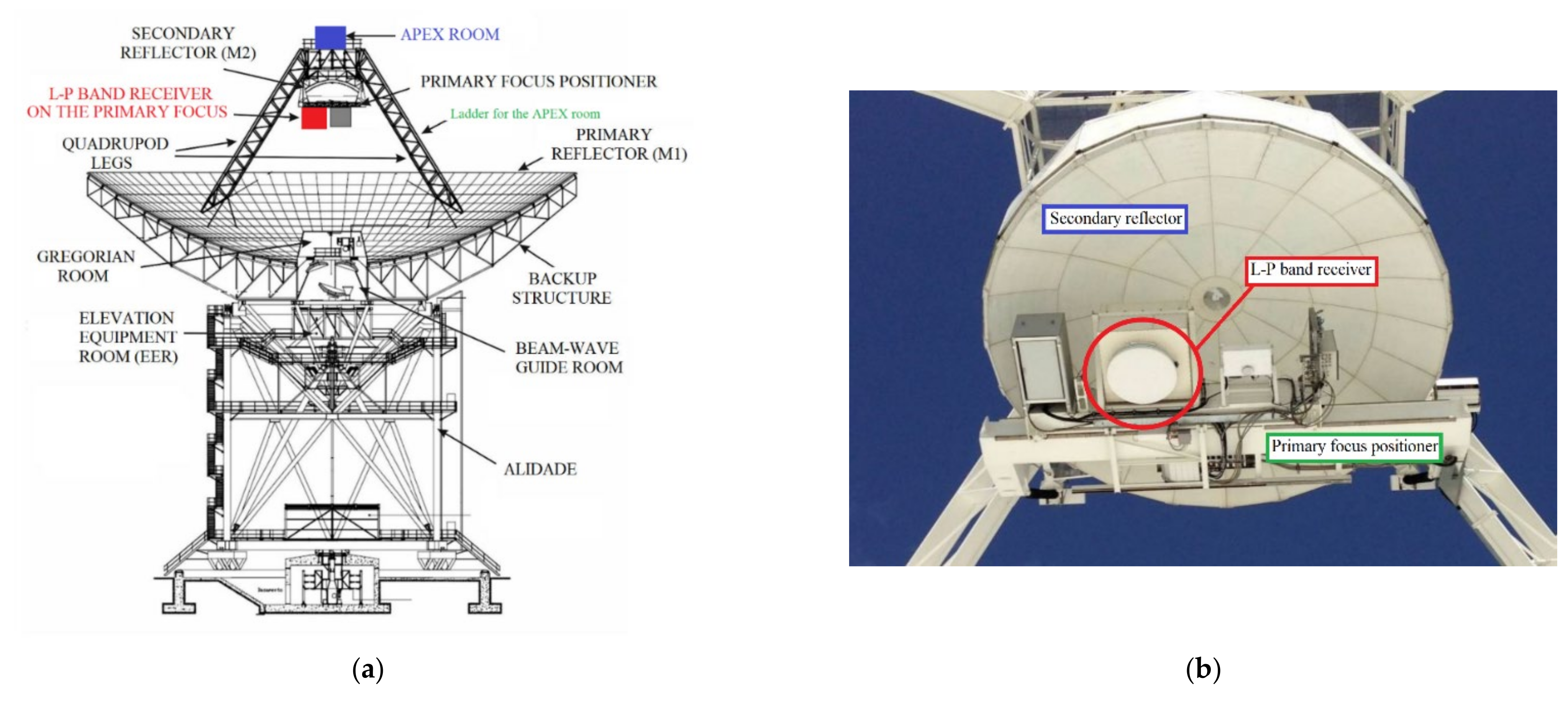
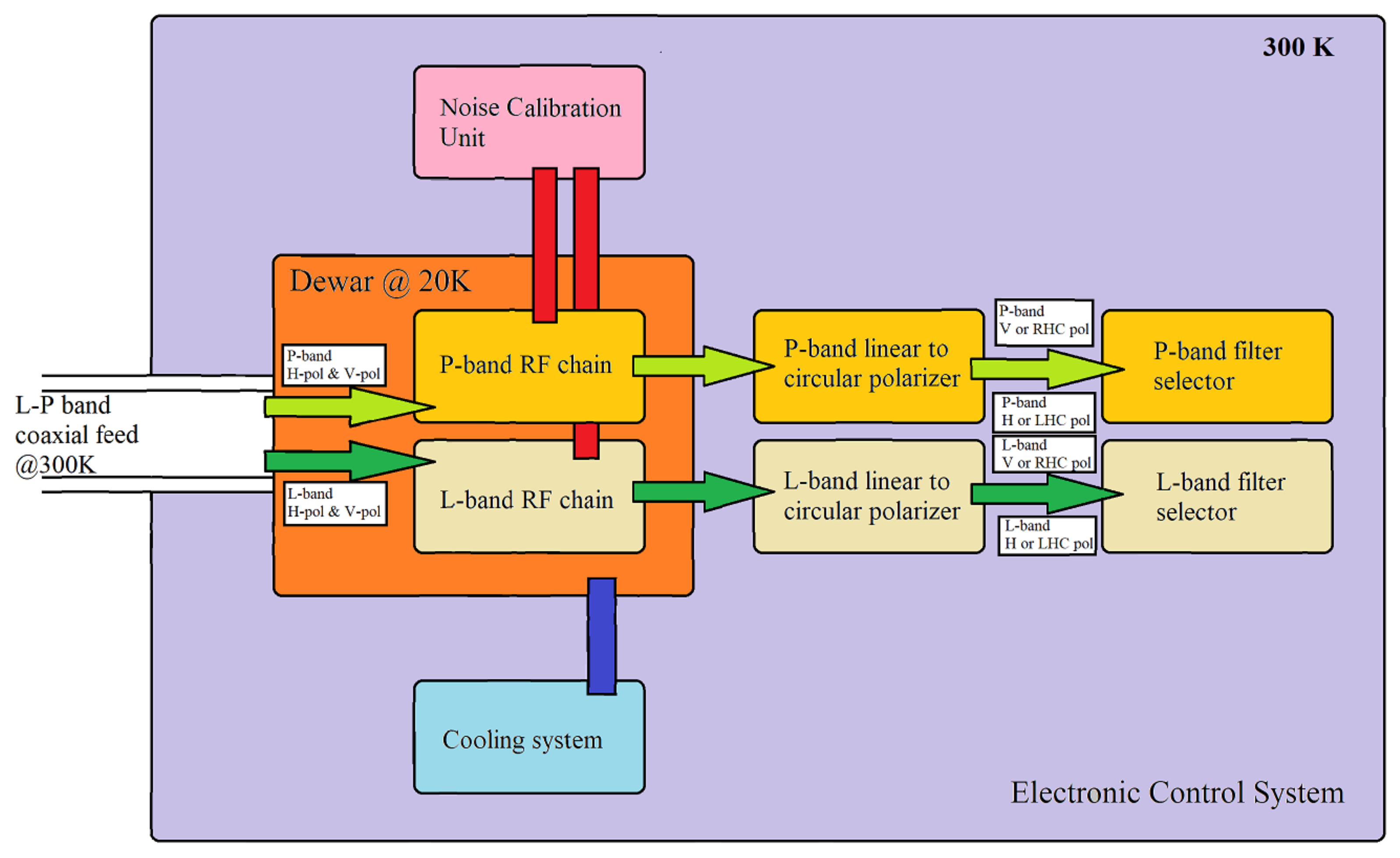
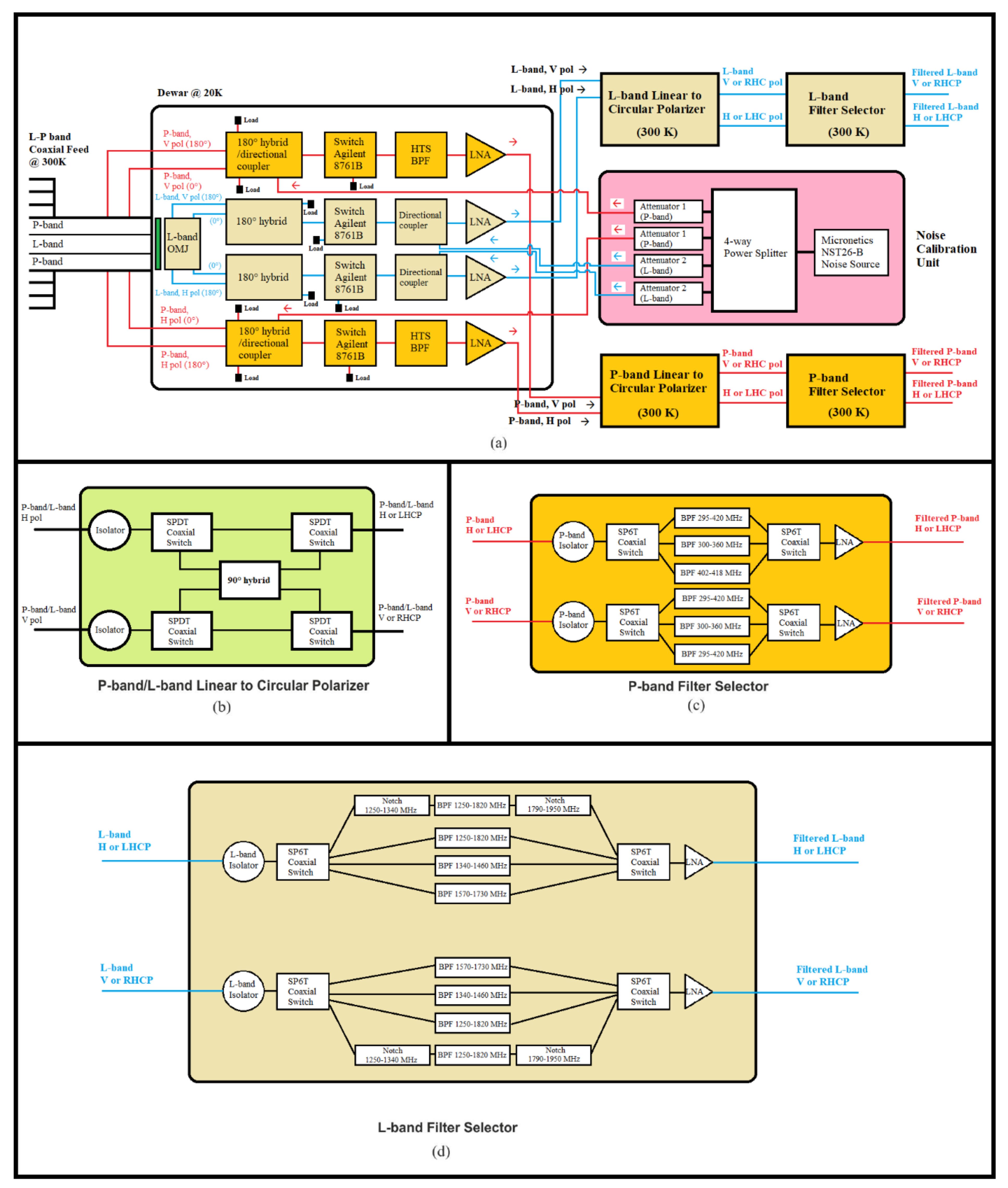




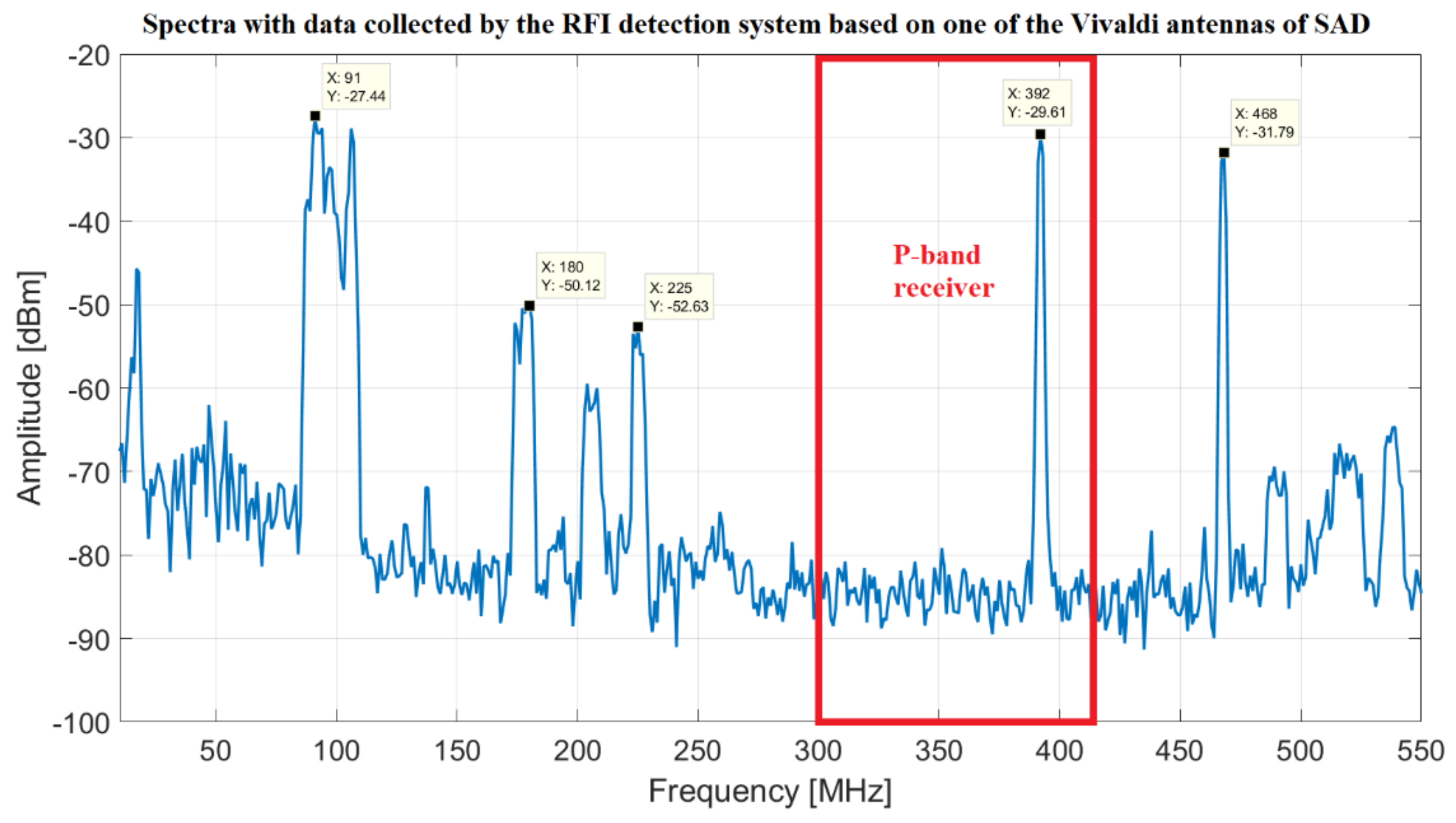
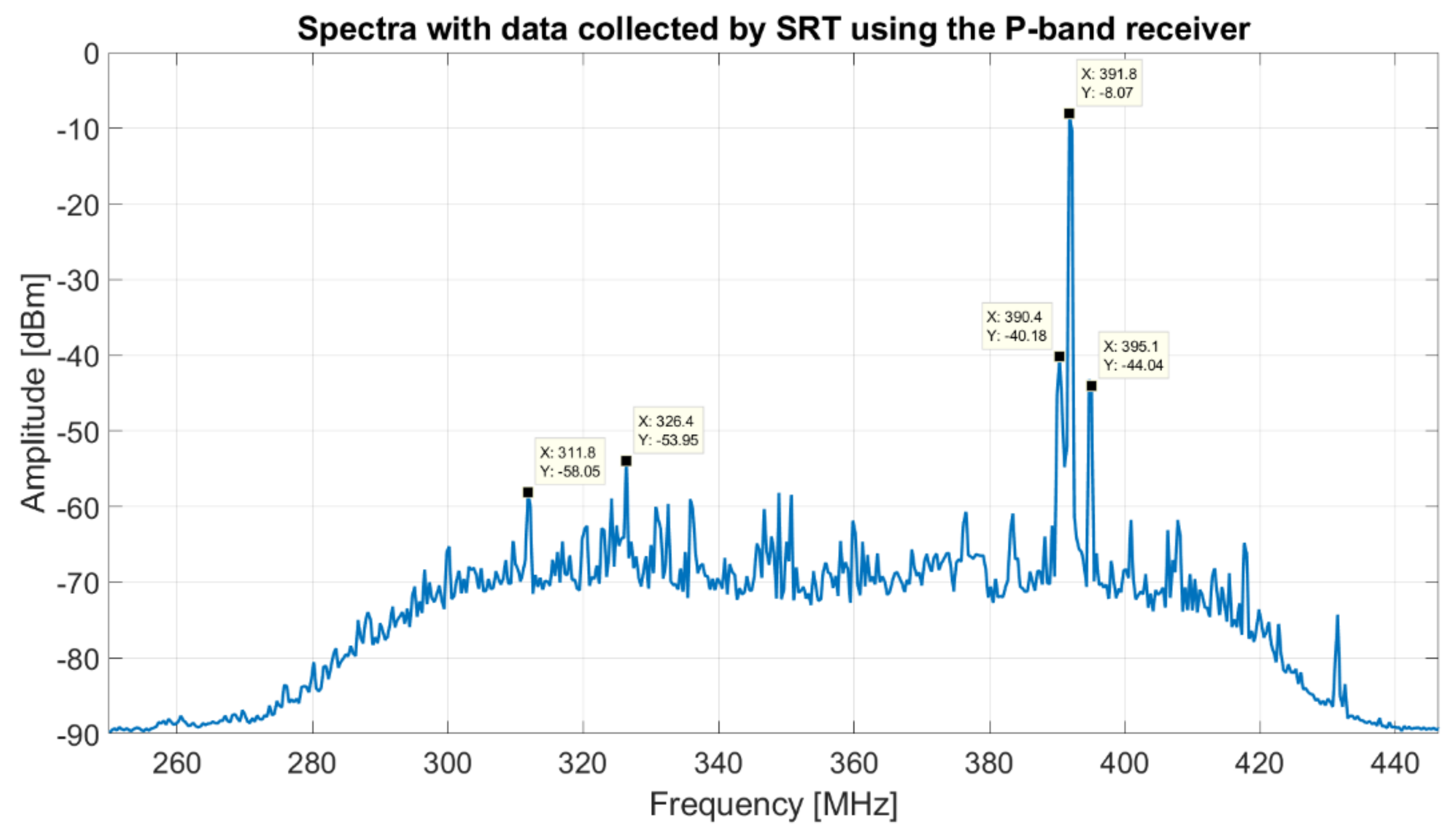
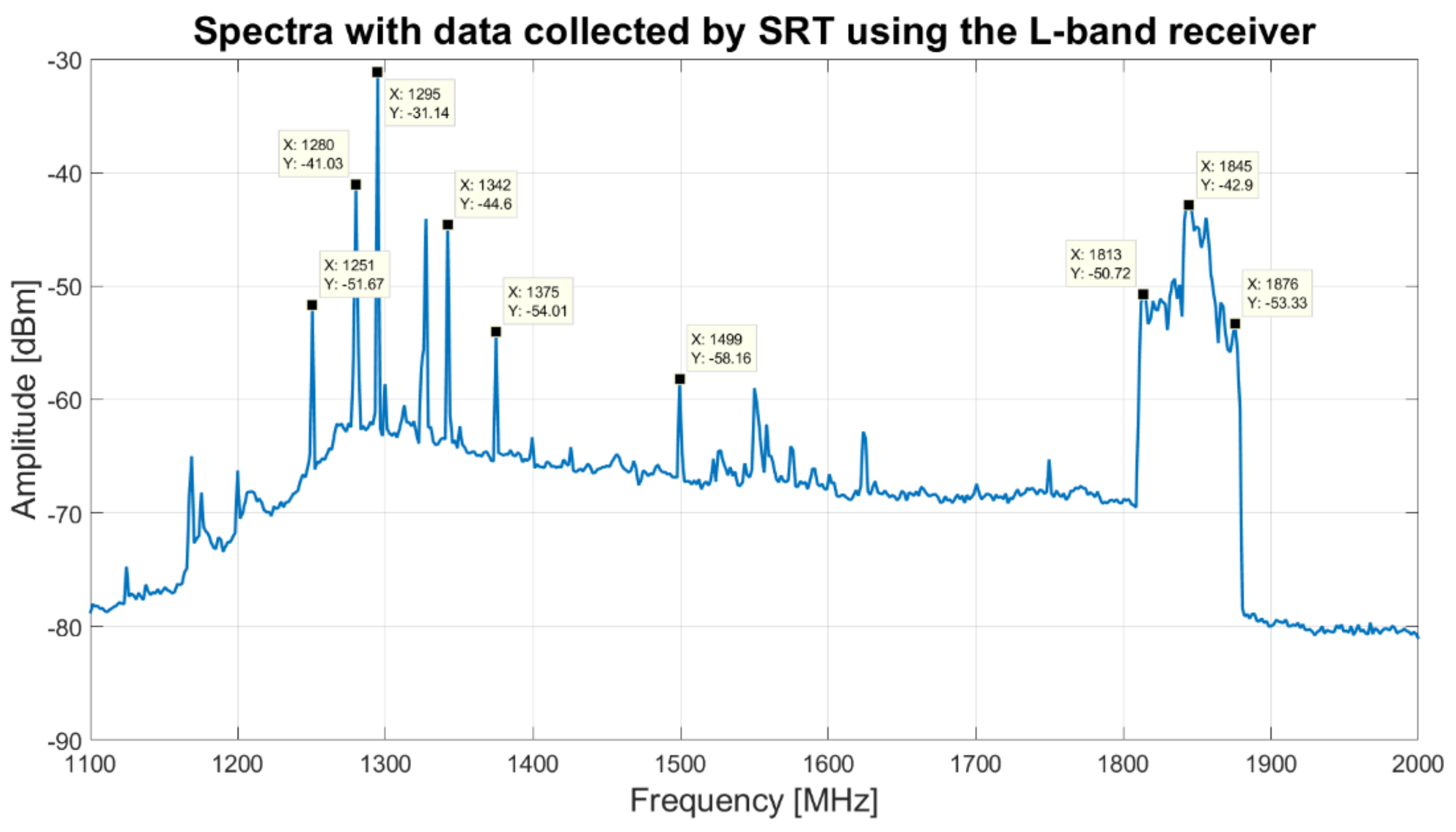
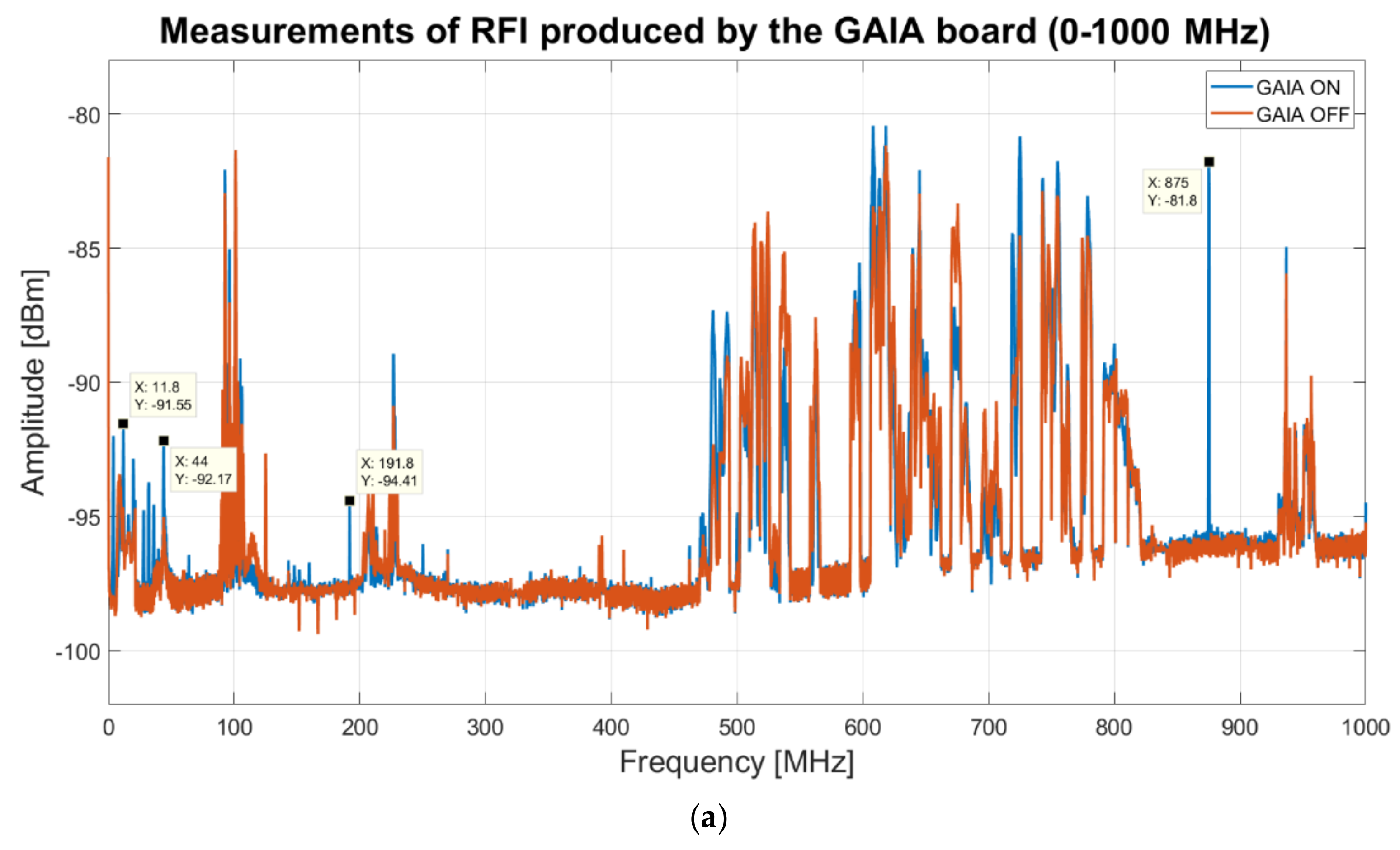

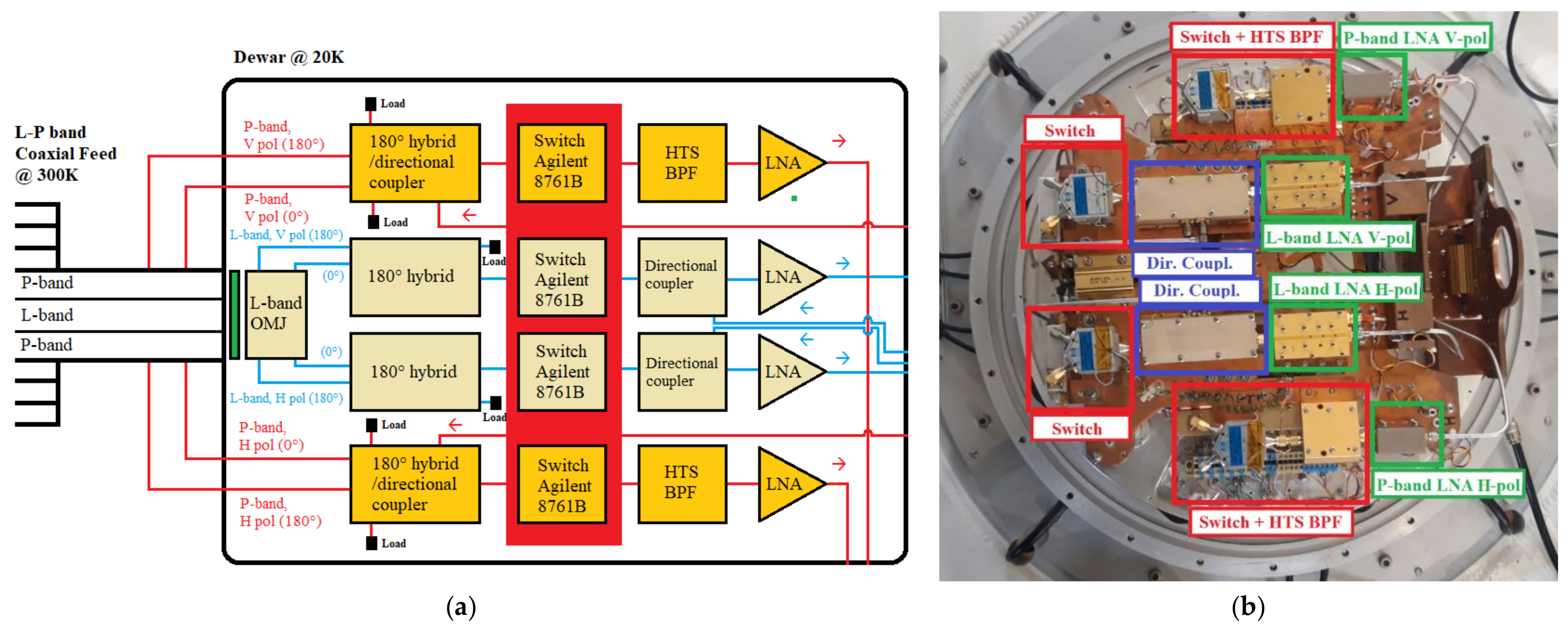
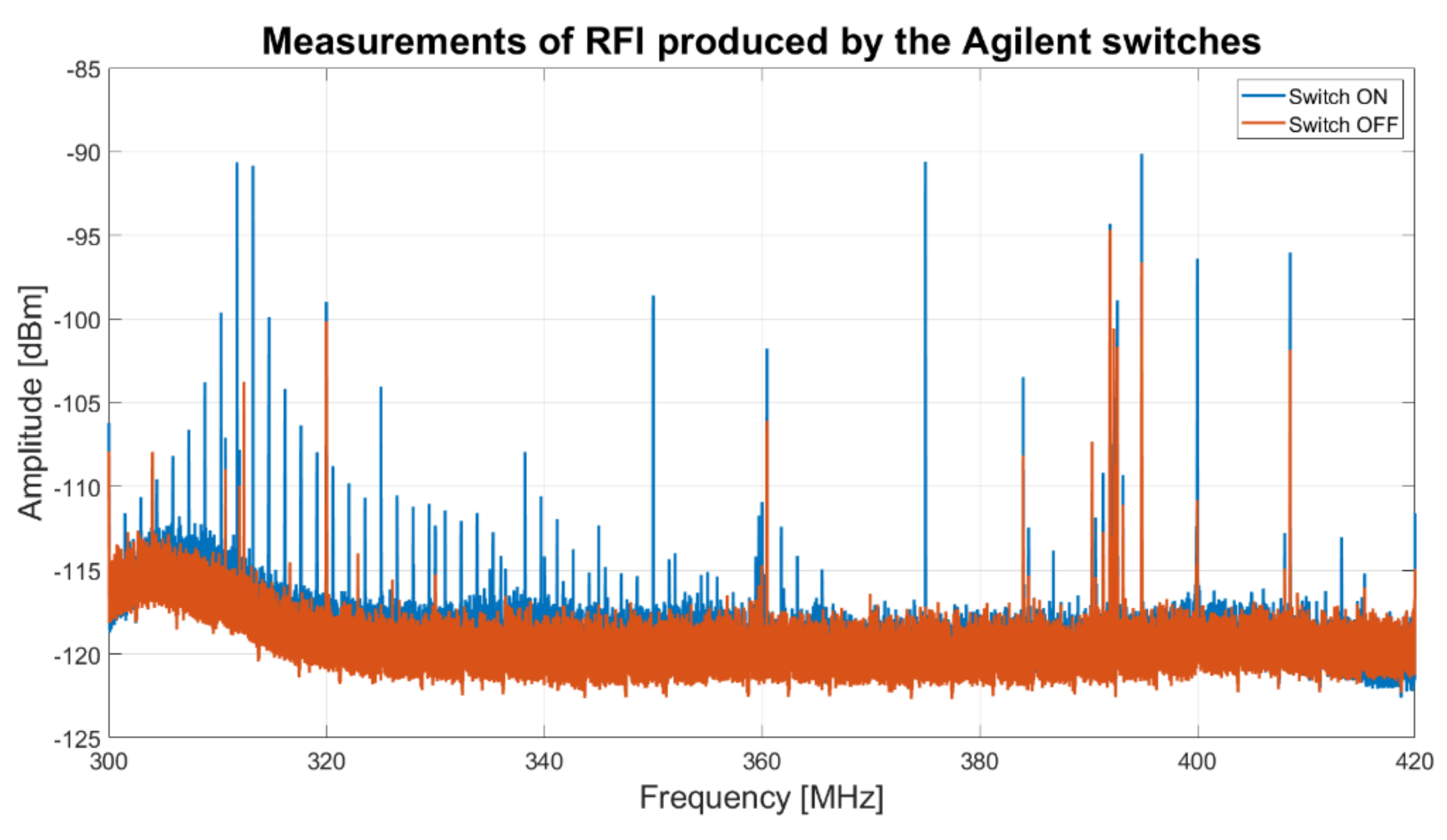


Publisher’s Note: MDPI stays neutral with regard to jurisdictional claims in published maps and institutional affiliations. |
© 2022 by the authors. Licensee MDPI, Basel, Switzerland. This article is an open access article distributed under the terms and conditions of the Creative Commons Attribution (CC BY) license (https://creativecommons.org/licenses/by/4.0/).
Share and Cite
Ladu, A.; Schirru, L.; Gaudiomonte, F.; Marongiu, P.; Angius, G.; Perini, F.; Vargiu, G.P. Upgrading of the L-P Band Cryogenic Receiver of the Sardinia Radio Telescope: A Feasibility Study. Sensors 2022, 22, 4261. https://doi.org/10.3390/s22114261
Ladu A, Schirru L, Gaudiomonte F, Marongiu P, Angius G, Perini F, Vargiu GP. Upgrading of the L-P Band Cryogenic Receiver of the Sardinia Radio Telescope: A Feasibility Study. Sensors. 2022; 22(11):4261. https://doi.org/10.3390/s22114261
Chicago/Turabian StyleLadu, Adelaide, Luca Schirru, Francesco Gaudiomonte, Pasqualino Marongiu, Gianmarco Angius, Federico Perini, and Gian Paolo Vargiu. 2022. "Upgrading of the L-P Band Cryogenic Receiver of the Sardinia Radio Telescope: A Feasibility Study" Sensors 22, no. 11: 4261. https://doi.org/10.3390/s22114261
APA StyleLadu, A., Schirru, L., Gaudiomonte, F., Marongiu, P., Angius, G., Perini, F., & Vargiu, G. P. (2022). Upgrading of the L-P Band Cryogenic Receiver of the Sardinia Radio Telescope: A Feasibility Study. Sensors, 22(11), 4261. https://doi.org/10.3390/s22114261





